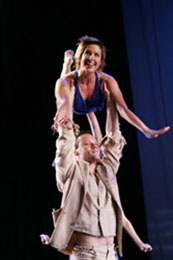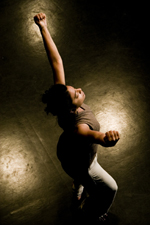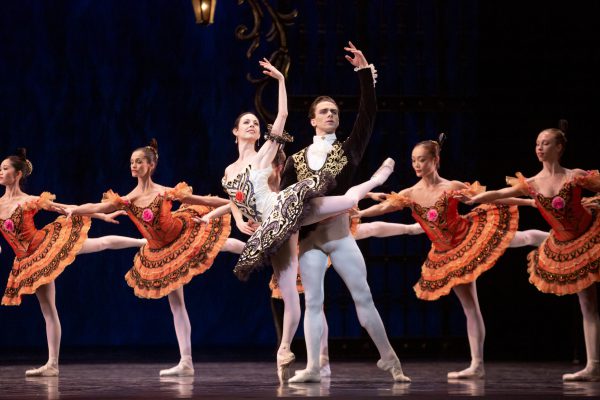For Chitralekha Odissi Dance Creations, it is the second year of a four-year cycle recounting the ancient Hindu story of four warriors. This year’s performance, “Drona”, which recounts the story of the Rishi (Sage) Drona in two distinct acts, ran from September 30th to October 2nd at the Leah Posluns Theatre in North York. Some time around 5000 BCE in India, a series of Hindu tales describing the events and concepts relating to the Kurukshetra War were documented in Sanskrit as the ‘Mahabharata Vira Quadrilogy’ from the Kurukshetra Chronicles. Hailed as India’s greatest epic, this religious literary work is the source of inspiration and interpretation for Chitralekha Odissi Dance Creations’s own epic dance and drama production of the Mahabharata as a four-year project. Artistic Director Devraj Patnaik is using Indian Classical dance and drama to tell the tale in four chapters: Chapter 1 – “Bhishma” 2003, Chapter 2 – “Drona” 2004, Chapter 3 – “Karna” 2005, and Chapter 4 – “Arjuna” 2006. Each chapter is dedicated to a particular warrior whose role in the epic is of special significance. In the manner of many Indian dance performances, the evening-length production of “Drona” commences with an invocation. As described in the program notes, this introductory piece, titled “Kurukshetra Stotra”, is dedicated to Lord Jagganath (the deity of Odissi Dance) and also honours Sri Vasudeva Krishna. A solo dancer lights incense at the foot of a shrine set in a downstage corner. As the smoke from the incense curls up into the darkness of the bare stage, recorded music plays, foreshadowing through lyrical poetry the sanguinary, warring nature of the narrative to come in Act II. With honest choreographic simplicity, the dancer prepares the stage space, the theatre and the audience for the sacred content of the presentation to follow. The next work on the program is “Pallavi (Raga Jog)”, a non-narrative, abstract Odissi choreography based on a melody or Raga described as “soft and lilting”. The dance is an expression of lively harmony, with the dancers costumed in complementary hues from a rich palette of bright colour. The elegant lines through the bodies of the six dancers resonate with the geometric floor patterns created by the ensemble. Rhythmic footwork punctuates the composition, and small hops accent various aspects of the multi-layered music. S-shaped curves, from the top of the head through the spine, give the dancers an elegant and sinewy quality, which is offset by exciting turns in which the upper body spirals off and around the vertical, making the dancers appear as if they are tracing the outer swirls of a whirlpool with their arms and torsos. The effect of multiplicity through unison dancing is mesmerizing. The dancers were rehearsed to simultaneous perfection, further enhancing the synergy between the individual dancers and the ensemble as a whole; and reflecting the parallel relationship between the dance and the music.
The final piece in Act I, “Bharadwaj”, is an abhinaya or expressive piece of Odissi dance. “Bharadwaj” is a short narrative in which the seven performers re-enact through Indian dance drama some of the events from the life of the Sage Bharadwaj (another Sage of the Vedic period). For the first time in the evening, the partitioning curtains, which hid the back half of the stage, are drawn to reveal a simple set of three broad steps or levels spanning the width of the upstage. This minimalist design was used to great effect during the remainder of Act I and throughout Act II, creating depth and, at times, demonstrating the hierarchical position of the characters. In contrast to “Pallavi” (the abstract dance piece), “Bharadwaj” uses more of the dramatic aspects of Odissi dance, thus incorporating more mudras (hand gestures) and theatrical mime-like movement into the choreography. Although the fundamental stylistic elements of Odissi dance are evident in both dances, in “Bharadwaj” there is a distinct difference in the movements of individual dancers, as the choreography defines the personality characteristics of each character in the story. By the end of Act I, the audience has experienced two very different stylistic approaches to Odissi dance, both abstract and narrative, in addition to the preparatory ritual. For those who are less familiar with the cultural context of Odissi a very brief historical description is included in the program. Odissi is a Classical Indian dance style that originated in the state of Orissa or Utkal as a temple dance in the second century BCE. The form was documented, in part, through sculptural carvings on the walls of various temples in East India. Although it was also recorded in Indian literature and poetry, the Odissi dance style fell out of common practice during the medieval period. Kept alive through the Gotipua folk dance tradition or Sakhi Nacha dance style, Odissi is experiencing a revival due to a renewed interest in the Odissi discipline both in India and abroad. Today, in Toronto, Chitralekha Odissi Dance Creations is effectively merging the traditional form with contemporary theatrical technology, and this was especially evident in second half of the evening. The Oriya Dance Drama “Drona” was divided into twelve scenes for Act II. The potentially confusing nature of the sophisticated storyline is brilliantly made accessible to those audience members new to the dance form or to this type of theatrical presentation. Before each scene commences, a voice-over briefly describes the elements to be portrayed. (This information is available in the program notes as well.) In addition, English sur-titles are projected above the stage space providing translation of the musical lyrics, which are important to understanding the storyline.
The rapid pacing of the drama keeps the development bold and exciting. With a large cast of dancers varying in age (there are many roles for and fulfilled by children), the production runs the risk of appearing overpopulated. Guru Sri Devraj Patnaik, who is responsible for the artistic concept, the musical composition and the choreography, ensured the efficient staging and theatrical focus of the production to an impressive degree. In addition, Patnaik also joins the cast of approximately forty performers on stage as the character Drona. The set design, lighting, props and costuming for “Drona” are more elaborate than in Act I. These include battle scenes with life-sized, wooden-horse-drawn carriages, court scenes with appropriately decorated chairs and thrones for the courtiers, a spirited dance with handkerchiefs in Scene Five, the added percussion of ankle bells on the corps dancers of scene Eight and, perhaps most impressive, the spectacular arrow-pierced deathbed of Scene Eleven where the character of Bhishma appears to be literally penetrated by dozens of blood-stained silver arrows. Beautifully and accurately co-ordinated with sound effects, the combat choreography uses imaginary weaponry, while the depiction of religious visions involving deities, the representation of memory and the foreseeing of future events are projected as short films on a descending screen, proving the effectiveness of imagination as well as technology. Chitralekha Odissi Dance Creations’ presentation of “Drona” was an all-consuming and powerful evening of dance and theatre. By successfully combining traditional and contemporary theatrical practices, Patnaik and company made an ancient dance form and epic Hindu story into an engaging theatrical production, accessible to a varied Canadian audience.
Tagged: Indian, Odissi, Performance, South Asian, ON , Toronto





